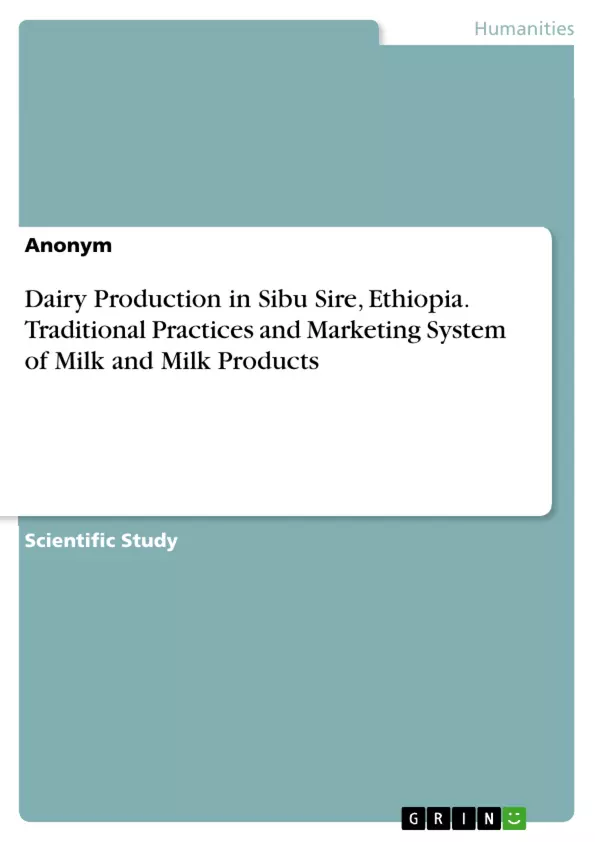The study was conducted in Sibu Sire District of eastern Wollega zone with the objective of to determine dairy production practice, traditional milk processing and to identify the marketing system of milk and milk products in the study area. A total of 6 kebeles were selected randomly. From each of the selected kebeles 30 households were purposively selected based on the owing of at least one local dairy cows and interviewed with open ended and close ended questionnaire.
Inhaltsverzeichnis (Table of Contents)
- Introduction
- MATERIAL AND METHODS
- Description of the Study Area
- Sampling Technique and Methods of Data Collection
- Data Collection
- Data analysis and statistical Model
- RESULT AND DISCUSSION
- Household Characteristics
- Dairy Cattle Production Practices
- Housing practice of cattle
- Feed Resources and Feeding practices
- Water source and watering practice (frequency of watering)
- Breeding practice of dairy cattle
- Health care practice of dairy cattle
- Milk Production
- Traditional Milk processing and utilization
- Traditional butter making
- Ghee making
- Marketing of Milk and Milk Products
- Price and Factors Affecting Price of Whole Milk and Butter
- Constraints of Dairy Cattle Production
- CONCLUSION AND RECOMMENDATION
- REFERENCES
Zielsetzung und Themenschwerpunkte (Objectives and Key Themes)
This study aimed to investigate dairy production practices, traditional milk processing techniques, and the marketing system for milk and milk products in the Sibu Sire District of eastern Wollega zone, Ethiopia. The research sought to understand the factors influencing dairy production and identify potential constraints and opportunities for improvement.
- Dairy Production Practices: This includes aspects like housing, feeding, breeding, and healthcare of dairy cattle.
- Traditional Milk Processing: The study focuses on techniques used for butter and ghee production.
- Marketing System: The research examines the informal marketing of milk and milk products in the study area.
- Constraints and Opportunities: The study investigates the challenges faced by dairy producers and explores potential areas for improvement.
- Socioeconomic Factors: The study analyzes the impact of household characteristics, including educational status, on dairy production practices.
Zusammenfassung der Kapitel (Chapter Summaries)
The study begins with an introduction that provides context on the global dairy industry and the importance of dairy production in Ethiopia. The second chapter delves into the research methodology, outlining the study area, sampling techniques, data collection methods, and data analysis techniques. The third chapter focuses on the results and discussion. This section provides detailed insights into the household characteristics of dairy producers in the study area and analyzes dairy cattle production practices, including housing, feeding, and breeding.
The chapter also explores milk production and the traditional processing of milk into butter and ghee. Additionally, the study investigates the informal marketing of milk and milk products, including price determinants and factors influencing pricing. The final section of this chapter discusses the constraints faced by dairy producers and potential avenues for improvement. The fourth chapter, "CONCLUSION AND RECOMMENDATION", provides a summary of the key findings and offers recommendations for enhancing dairy production in the study area.
Schlüsselwörter (Keywords)
The study's primary focus is on dairy production practices, traditional milk processing, and marketing of milk and milk products in the Sibu Sire District of eastern Wollega zone, Ethiopia. Key terms associated with the research include dairy production, traditional processing, marketing, milk, butter, ghee, constraints, opportunities, and socioeconomic factors. The research delves into the challenges faced by dairy producers in the region and aims to inform strategies for improvement.
- Quote paper
- Anonym (Author), 2016, Dairy Production in Sibu Sire, Ethiopia. Traditional Practices and Marketing System of Milk and Milk Products, Munich, GRIN Verlag, https://www.hausarbeiten.de/document/1043295


